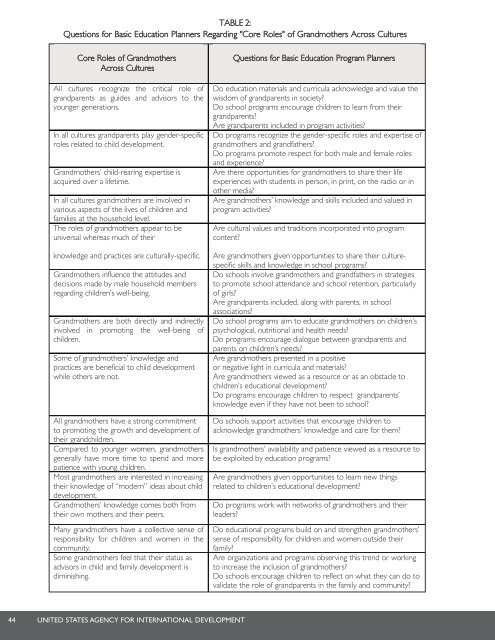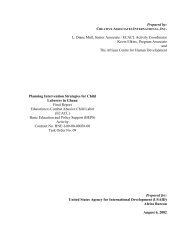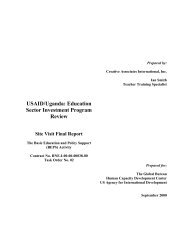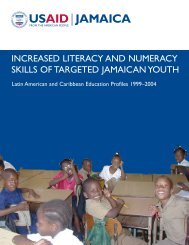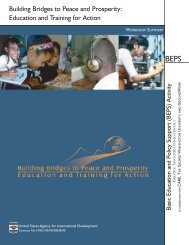Grandmothers: A Learning Institution - Basic Education and Policy ...
Grandmothers: A Learning Institution - Basic Education and Policy ...
Grandmothers: A Learning Institution - Basic Education and Policy ...
- No tags were found...
You also want an ePaper? Increase the reach of your titles
YUMPU automatically turns print PDFs into web optimized ePapers that Google loves.
TABLE 2:Questions for <strong>Basic</strong> <strong>Education</strong> Planners Regarding "Core Roles" of <strong>Gr<strong>and</strong>mothers</strong> Across CulturesCore Roles of <strong>Gr<strong>and</strong>mothers</strong>Across CulturesQuestions for <strong>Basic</strong> <strong>Education</strong> Program PlannersAll cultures recognize the critical role of Do education materials <strong>and</strong> curricula acknowledge <strong>and</strong> value thegr<strong>and</strong>parents as guides <strong>and</strong> advisors to the wisdom of gr<strong>and</strong>parents in society?younger generations.Do school programs encourage children to learn from theirgr<strong>and</strong>parents?Are gr<strong>and</strong>parents included in program activities?In all cultures gr<strong>and</strong>parents play gender-specific Do programs recognize the gender-specific roles <strong>and</strong> expertise ofroles related to child development.gr<strong>and</strong>mothers <strong>and</strong> gr<strong>and</strong>fathers?Do programs promote respect for both male <strong>and</strong> female roles<strong>and</strong> experience?<strong>Gr<strong>and</strong>mothers</strong>’ child-rearing expertise is Are there opportunities for gr<strong>and</strong>mothers to share their lifeacquired over a lifetime.experiences with students in person, in print, on the radio or inother media?In all cultures gr<strong>and</strong>mothers are involved in Are gr<strong>and</strong>mothers’ knowledge <strong>and</strong> skills included <strong>and</strong> valued invarious aspects of the lives of children <strong>and</strong> program activities?families at the household level.The roles of gr<strong>and</strong>mothers appear to be Are cultural values <strong>and</strong> traditions incorporated into programuniversal whereas much of theircontent?knowledge <strong>and</strong> practices are culturally-specific.<strong>Gr<strong>and</strong>mothers</strong> influence the attitudes <strong>and</strong>decisions made by male household membersregarding children’s well-being.<strong>Gr<strong>and</strong>mothers</strong> are both directly <strong>and</strong> indirectlyinvolved in promoting the well-being ofchildren.Some of gr<strong>and</strong>mothers’ knowledge <strong>and</strong>practices are beneficial to child developmentwhile others are not.Are gr<strong>and</strong>mothers given opportunities to share their culturespecificskills <strong>and</strong> knowledge in school programs?Do schools involve gr<strong>and</strong>mothers <strong>and</strong> gr<strong>and</strong>fathers in strategiesto promote school attendance <strong>and</strong> school retention, particularlyof girls?Are gr<strong>and</strong>parents included, along with parents, in schoolassociations?Do school programs aim to educate gr<strong>and</strong>mothers on children’spsychological, nutritional <strong>and</strong> health needs?Do programs encourage dialogue between gr<strong>and</strong>parents <strong>and</strong>parents on children’s needs?Are gr<strong>and</strong>mothers presented in a positiveor negative light in curricula <strong>and</strong> materials?Are gr<strong>and</strong>mothers viewed as a resource or as an obstacle tochildren’s educational development?Do programs encourage children to respect gr<strong>and</strong>parents’knowledge even if they have not been to school?All gr<strong>and</strong>mothers have a strong commitment Do schools support activities that encourage children toto promoting the growth <strong>and</strong> development of acknowledge gr<strong>and</strong>mothers’ knowledge <strong>and</strong> care for them?their gr<strong>and</strong>children.Compared to younger women, gr<strong>and</strong>mothers Is gr<strong>and</strong>mothers’ availability <strong>and</strong> patience viewed as a resource togenerally have more time to spend <strong>and</strong> more be exploited by education programs?patience with young children.Most gr<strong>and</strong>mothers are interested in increasing Are gr<strong>and</strong>mothers given opportunities to learn new thingstheir knowledge of “modern” ideas about child related to children’s educational development?development.<strong>Gr<strong>and</strong>mothers</strong>’ knowledge comes both from Do programs work with networks of gr<strong>and</strong>mothers <strong>and</strong> theirtheir own mothers <strong>and</strong> their peers.leaders?Many gr<strong>and</strong>mothers have a collective sense of Do educational programs build on <strong>and</strong> strengthen gr<strong>and</strong>mothers’responsibility for children <strong>and</strong> women in the sense of responsibility for children <strong>and</strong> women outside theircommunity.family?Some gr<strong>and</strong>mothers feel that their status as Are organizations <strong>and</strong> programs observing this trend or workingadvisors in child <strong>and</strong> family development is to increase the inclusion of gr<strong>and</strong>mothers?diminishing.Do schools encourage children to reflect on what they can do tovalidate the role of gr<strong>and</strong>parents in the family <strong>and</strong> community?44 UNITED STATES AGENCY FOR INTERNATIONAL DEVELOPMENT


